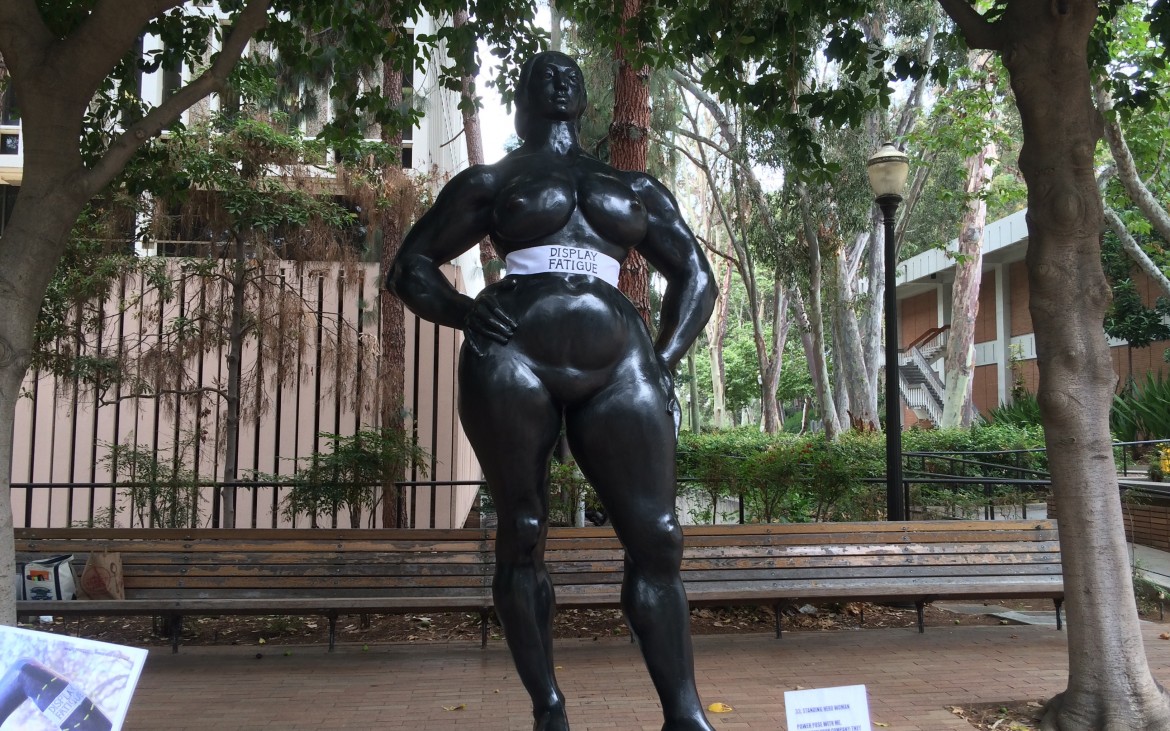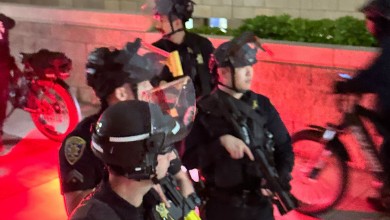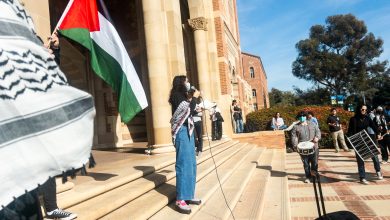Display Fatigue: A Feminist Read on UCLA’s Sculpture Garden

Featured photo: Rebecca Whitney by Regina Napolitano.
Last Thursday, I power posed across from “Standing Hero Woman” in the Franklin D. Murphy Sculpture Garden at UCLA. I puffed my chest out, stood up straight, put my hands on my hips, held my head high, and stared at the bronze statue. That day, she had a stick resting on her pedestal, a whole fruit, a purple flyer, a framed photo of herself and Yoko Ono, a ribbon wrapped around her waist, and a small yard sign resting on a piece of clay.
The ribbon said “DISPLAY FATIGUE” and the yard sign suggested, “MUSES claim direction of the forces! Hold a 2 minute Power Pose with Isabel for the scientifically proven result of-increased PRESENCE.” Truly, I was only following directions.
These additions to “Standing Hero Woman” were a part of Display Fatigue, a feminist arts intervention into UCLA’s Sculpture Garden conceived by fourth year World Arts and Cultures/Dance undergrad Rebecca Whitney. This day of action and intervention was a part of Whitney’s larger senior research project about feminism and the sculpture garden.

On the day in question, Whitney wrapped Display Fatigue ribbons around every nude female sculpture, placed yard signs with funny and critical messages in front of the nudes, highlighted the few sculptures in the garden made by women, passed out copies of her feminist guide to the garden, and talked to passersby who were trying to figure out what was going on.
To explain her intervention, Whitney said, “I know they’re sculptures, not people! But, I sincerely longed to give them a break, and by extension, all women, a break from posing and posturing for onlookers, most especially the male gaze.”
Whitney’s project connects to a larger issue about representation for female artists in the fine arts world. In 1989, female arts collective Guerilla Girls, asked, “Do women have to be naked to get into the Met. Museum?” and so Whitney asked, do women have to be naked to get into the UCLA Sculpture Garden?
Unfortunately, that seems to be the general case. The UCLA Sculpture Garden was founded in 1967 and is considered a closed collection. Most of the sculptures were created before the garden’s inception, and they mainly reflect Eurocentric and patriarchal values. There are 72 sculptures in the garden. Only six of them were created by four unique women artists. And none of the artists are women of color. By contrast, 10 out of 11 of the nude sculptures are female. So, by Whitney’s own calculation, fewer than eight percent of the artists in the garden are women while 94 percent of the nudes are female.
The intervention was a day to critique and question this ratio and wonder why women in art are more often objects than creators. Whitney said that the concept of “Display Fatigue” itself “addresses the exhaustive nature of women being on display for the heterosexual male gaze.”
The use of the word intervention is also important here. Whitney said that a large part of her project is recognizing that the UCLA Sculpture Garden is not merely a backdrop for our lives, but a space that speaks with us. I must admit that despite three years of gender studies training, I had been very content to sit and admire the sculptures without once thinking about gender. But the sculptures, the people who made them, and the people who posed for them communicate with their audience. Indeed, critiquing culture means recognizing that the media we consume does not simply pass through us. Its messages have real effects on our lives. And when the overwhelming majority of people who get to speak are white men, the messages are often warped.
Whitney’s intervention questioned the kind of messages the nudes in the sculpture garden send. One particularly alarming example is “Victory,” a 1950 golden statue of a woman’s body—without a head, arms, or legs, naturally. It was given as gift to celebrate the Allies victory in WWII, but Whitney points out that it is an example of a woman’s body literally conceived of as a prize instead of as a part of a person.
In the words of one of the Guerilla Girls herself, “Culture is the story of everyone, and how can you really tell the story of a culture when you don’t include all the voices within the culture. Otherwise, it’s just the history and the story of power.”
Whitney and Guerilla Girls ask us to question this history. So, next time you’re in a museum, ask why there aren’t more female artists, or artists of color, and think about the messages the art communicates. And maybe, try power posing next to some sculptures. It really does improve self-confidence.




